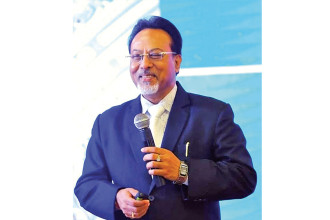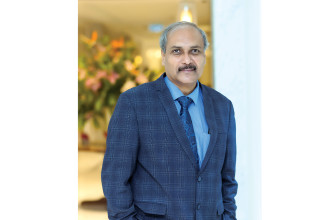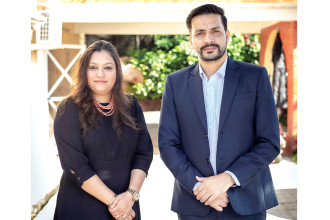Hitendra Dev Shakya
Managing Director, Nepal Electricity Authority
Hitendra Dev Shakya, Managing Director of Nepal Electricity Authority– the country's sole power offtaker - was appointed to his position by the government on March 24 this year amidst varying degrees of political and public interest and critique.
An electrical engineer by profession, Shakya has held various directorial positions within NEA and led the NEA Engineering Company, a subsidiary of NEA. He has played a crucial role in framing the Transmission Masterplan of NEA. Shakya is recognized as energy expert and been associated with various national and international agencies in different capacities.
Incidentally, he had previously served as Managing Director of NEA in February 2021 for a short period of less than a year before the erstwhile government ousted him from the position. After assuming office again as the Managing Director, Shakya is preparing to release a whitepaper that maps the true status of the NEA citing that the exaggeration of information in the past has pushed NEA into over-politicisation.
In a candid interview with Business 360, Shakya spoke on various dimensions of Nepal's energy sector and his priorities as NEA’s Managing Director. Excerpts:
What are your top priorities as Managing Director of Nepal Electricity Authority?
My top priority as the Managing Director of Nepal Electricity Authority is to ensure the supply of reliable electricity. To achieve this target, we have to strengthen the transmission and distribution networks, substations and cable lines. Regarding regular supply, we will utilise electricity generated in Nepal and also import from India to bridge the gap in demand and supply. Currently, there is sufficient generation in Nepal for the wet season and we are gradually becoming self-reliant in generation during the dry season as well. But, the mismatch in demand and supply in the dry season will continue for a few more years.
However, in the current situation, strengthening transmission and distribution system is more challenging than electricity generation and it is critical. Investment in strengthening transmission and distribution system is more concentrated in major load centres such as Kathmandu and other cities. I have prioritised reliable electricity supply in industries as well.
The demand for electricity goes way up in the dry season but the amount of power we get from our snow-fed rivers drops a lot. How do you ensure consistent supply of electricity during this time?
So far, the highest amount of electricity we have needed at one time has been about 2,400 MW. We think this will go up in the summer. During the dry season, the amount of electricity Nepal generates drops to around 1,800 to 1,900 MW. If it rains early, we might get more electricity from run-of-the-river projects.
There is outrage regarding industrial load-shedding. How long will it take to completely eliminate industrial load-shedding?
Uninterrupted power supply to industrial areas will be challenging till mid-May and it will also be challenging to manage reliable supply in some pocket areas like Birgunj and Nepalgunj in the summer due to inadequate transmission network. We will request the industries to adjust and minimise their load so that we can provide 24/7 electricity to households. We will be able to supply reliable electricity after strengthening the transmission networks.
Does this mean there will be no load-shedding for the general public?
It is an understood fact. The current challenge is supply of reliable electricity which means minimising tripping to the best extent possible. Reliable electricity supply requires a robust transmission and distribution system; it is not about verbal announcement or commitment; we have to be rationale.
To develop a robust system requires huge investment. We have to fix the leaning electricity poles, move the cables that are too close to the ground, and replace the old transformers that can't handle much power. However, we are facing challenges of investments. Currently, we have some projects under loan support of Asian Development Bank, Asian Infrastructure Investment Bank and European Investment Bank.
The ADB project addresses reliable electricity supply in Madhesh and Bagmati provinces. We have also been strengthening the transmission and distribution system in Karnali and Sudurpashchim provinces under financing of Asian Infrastructure Investment Bank and European Investment Bank. Besides these projects, NEA has to invest to enhance the transmission and distribution system in other provinces as well as in Madhesh Province.
The issue of dedicated tariff has been highly politicised. What exactly is the issue and how is the tariff being recovered from industries that consumed electricity under this scheme?
The main idea behind the special pricing for industries is to give them constant supply of electricity. Especially in poorer countries, it is really important to prioritise giving industries reliable power supply. This helps them make more goods, create jobs and increase exports which can help the country's economy.
I am not saying that homes are not important; giving electricity to households is definitely a priority. In a democracy, what the public wants matters a lot and is politically sensitive. That is why we focused on getting rid of power cuts for homes first. But if you ask an economist, they might say it is better to give electricity to industries first because it can boost the economy in many ways.
Back in Fiscal Year 2012/13, the government announced a plan to supply electricity through special lines and asked interested companies to apply. The price for using electricity through these special lines was quite high as decided by the Electricity Tariff Fixation Committee. The government had promised to provide reliable electricity during set times by buying it from India or using other ways to generate power like thermal plants. The prices for these special lines were 65% higher than the usual prices for industries.
After some time, NEA announced that it could not supply electricity under this special plan anymore. However, after 2016, it became easier to buy more electricity from India and some new power plants started working. Because of this, NEA gradually got rid of power cuts, first for homes and then for industries. NEA made a mistake by not deciding sooner whether to charge the special prices based on the data from the special meters, as there was a clear rule for this. NEA messed things up by making the special lines seem unimportant after the power cuts were gone. Now, people are questioning why we are charging the special prices three years later.
NEA should have charged the tariffs immediately based on how much electricity was used but we sent the bills after three years because of our own mistakes. Whoever made these mistakes, the prices charged to the industrialists are fair, and we need to collect that money. In the meantime, the government created a commission, the Lal Commission, which told us to collect the money based on proof of how much electricity was used.
The rules for allowing private companies to invest in power lines are coming soon. Before I became the head of NEA, I advised the government as an expert to let private companies invest in transmission lines. NEA is open to private investment in both the transmission and distribution systems. Since NEA really needs funds, it does not make sense for us to keep all the work on power line infrastructure under our control. We can build these kinds of infrastructure through public-private partnerships and that would be more efficient.
Is NEA following the Lal Commission's recommendation to collect the outstanding dues?
We are going to follow what the government decided through our own procedures. Our process says that companies need to guarantee a certain part of the bill amount before they can file a complaint for us to review. The committee we have created at NEA has to make a decision within 35 days after a complaint is filed. We have already set up this committee and companies can file a complaint by guaranteeing 5% of the bill. The committee will try to find a friendly solution within 35 days. If the company does not agree with the solution, they can take legal action in court.
When you took over as the Managing Director of NEA, you talked about starting some important projects. What are the main electricity generation projects that NEA wants to get started on immediately?
Even though big storage projects are what NEA wants most, they take a long time to get done. Right now, we only have the Kulekhani storage project, and the Seti Hydroelectric Project has been under construction for ten years already and might take a few more years to finish. We definitely want more reservoir projects but they could take awhile to build.
For the near future and the medium term, to make sure we have enough electricity, we need to think about battery storage and pump storage projects. Battery storage can give us a solution quickly for the next dry season, while pump storage might take another two years to set up completely. Battery storage is mostly about buying and installing the equipment. Because we do not have unlimited money, we might start with a smaller battery storage system. The battery storage project can work financially if we use some of the money we get from tariffs to help pay for it. That is why we should look into getting loans with lower interest rates to fund these battery storage projects.
Is there possibility to invest in new projects from the profit generated by NEA?
Right now, the actual money NEA has is stopping us from investing in new projects. The profit that we see on paper has not actually been received yet. For example, we still need to get back Rs 22 billion from the special tariffs. We also need to get money from the government for the times we did not charge for services during the Covid 19 pandemic as they had announced, and for things like street light charges. This does not mean we are losing money overall. We are making a profit. However, we are spending more money than we are bringing in. NEA has been slowly paying contractors and asking them for more time. We are using 5-6 months of this year's income to pay off the debts from last year, and we still have outstanding payments to make.
How much resource does NEA require to establish a robust distribution system?
In the current FY 2024/25, our total budget is Rs 230 billion but we are short by about Rs 40 billion. Most of the money we spend goes to buying electricity, then towards running the company, and then paying royalties to the government. The money left after is used for big investments.
The government gives loans to NEA. In this financial year, the profit we make will only be enough to pay back the main part of the loans and the interest to the government which is about Rs 11 billion. The government has set aside Rs five billion for NEA.
Because we do not have a lot of money, we need to look for funding from other organisations and development partners. Given this situation, NEA cannot easily invest in big electricity generation projects right now. So, NEA has been thinking about selling bonds and getting loans from banks to get the money we need.
NEA was supposed to develop Upper Arun and Dudhkoshi hydroelectric projects. What is the status of these large-scale projects?
We were supposed to avail a loan from the World Bank Group for Upper Arun, however the loan has yet to be approved. Meanwhile, the Asian Development Bank has already approved the loan for Dudhkoshi Storage Hydroelectric Project and we are close to achieving financial closure. However, there are certain conditions that need to be fulfilled by NEA and they are in process. It might take some time to commence the construction works of Dudhkoshi Storage Project.
You are credited for leading the Transmission Masterplan. How do you plan to implement it?
NEA developed the Transmission Masterplan in 2016 and I was involved in it. The Government of Nepal approved the Transmission Masterplan but made some changes based on input from the Rastriya Prasaran Grid Company Ltd (RPGCL). Now, the different power lines that are part of this plan are being built.
There have been allegations from independent power producers that NEA has halted the PPA of run-of-the-river projects on the basis of suppressed demand forecast…
The idea of ‘suppressed demand’ is really hard to pin down. Sometimes, even when there is enough electricity available, people do not use more because the electricity is not always reliable and the prices have gone up. Just homes using more electricity will not make a big difference in how much energy is used overall. It tends to grow at a steady pace, similar to how the country's economy grows. If the economy grows by 5-6%, electricity use only goes up by about 15%-16%.
To reach the goal of everyone using 1,500 kilowatt-hours of electricity per year by 2030, we need electricity use to grow by at least 20% to 25% each year. Right now, each person only uses about 410 kilowatt-hours per year, so we need to triple that amount by 2030. To get halfway to that goal in the next four years, we need to see a 20% increase each year.
Getting people to use more energy depends a lot on industries needing more power, people using electricity for cooking instead of other fuels and using electric vehicles. This does not mean we are not signing agreements to buy power from independent power producers because we still do not have enough electricity during the dry season. The fact that we have had to buy more energy from India in the dry season means we need to rethink our plans for the winter and how to use the extra energy we have during the rainy season. We need to find a good balance between how much electricity we have and how much people need. We can sell extra electricity on India's energy market for the next day but it is hard to get the price we want there. However, we still have to pay the independent power producers a certain amount based on our agreements with them.
NEA has been a highly politicised organisation but being an entity made of technical experts, how will you work to reduce the political influence and reshape NEA's image?
NEA was and will continue to be a professional organisation. However, recently it has received a lot of attention from the media. When people within the organisation started taking credit and blaming others, that is when politics got involved. We are slowly working to make NEA look like a professional organisation again. We do not think it is right to share exaggerated information in the media to make ourselves look good or to blame others. Instead, we need to present accurate information about NEA and we are going to release a detailed report to do just that. At the same time, we need to build trust among everyone who have a stake in NEA. We will focus on doing our jobs professionally. Supplying electricity is a vital service, and as part of the Government of Nepal, it is our duty to provide reliable electricity to the people who use it.
Considering private companies are very interested in investing in power lines for electricity trading, has NEA allowed private investment in these transmission lines?
The rules for allowing private companies to invest in power lines are coming soon. Before I became the head of NEA, I advised the government as an expert to let private companies invest in transmission lines. NEA is open to private investment in both the transmission and distribution systems. Since NEA really needs funds, it does not make sense for us to keep all the work on power line infrastructure under our control. We can build these kinds of infrastructure through public-private partnerships and that would be more efficient.
Private companies have suggested directly negotiating power trading deals with electricity companies in India and Bangladesh and they are also interested in investing in electricity generation projects here. Is this feasible?
I have some reservations about that idea. We should export electricity only after we have used up the cheaper electricity in Nepal ourselves. If we let private companies trade power directly, they might end up exporting our cheaper energy to other countries in the region. Right now, private companies sell all the electricity they produce to NEA through agreements, so they do not have any extra energy to sell on the international market. However, this could change in the future.
Hydropower comes from Nepal's natural resources, so the people of Nepal should be the first to benefit from it. We should only trade the energy we have left over. This means that companies that get a licence to trade power should only be allowed to sell it internationally if NEA gives them permission. Unless NEA allows private companies to do so, they should not be able to trade directly.
Lastly, as an energy expert, how do you envision the energy landscape in 10 years?
The energy situation is changing. About two years ago, I wrote an article saying that the prime time for hydropower is only about ten years; after that, any hydropower projects built will likely be part of bigger, multi-purpose projects that also include things like irrigation, water supply, tourism, recreation and fishing. The cost of building hydroelectric plants has been going up and we have pretty much found all the projects that make economic sense. At the same time, the cost of solar power is dropping significantly and battery storage is also getting much cheaper, almost halving in price in just five years. Because of these different factors, hydropower is slowly becoming less important.






